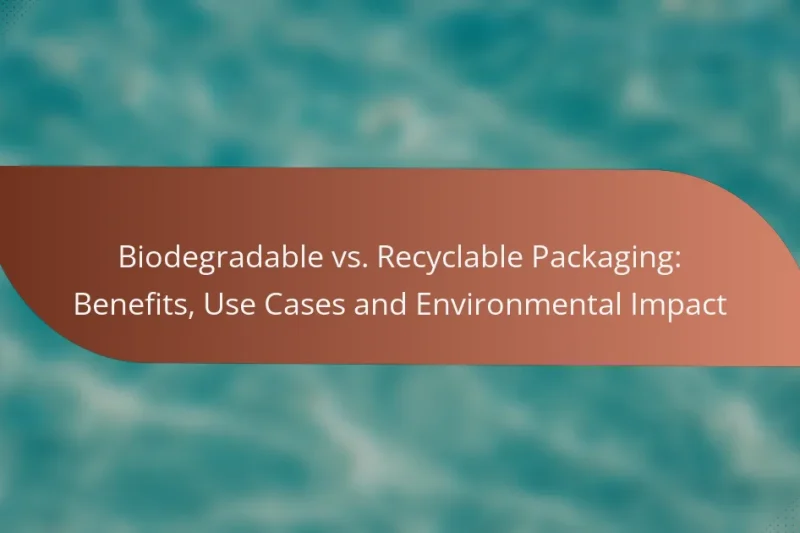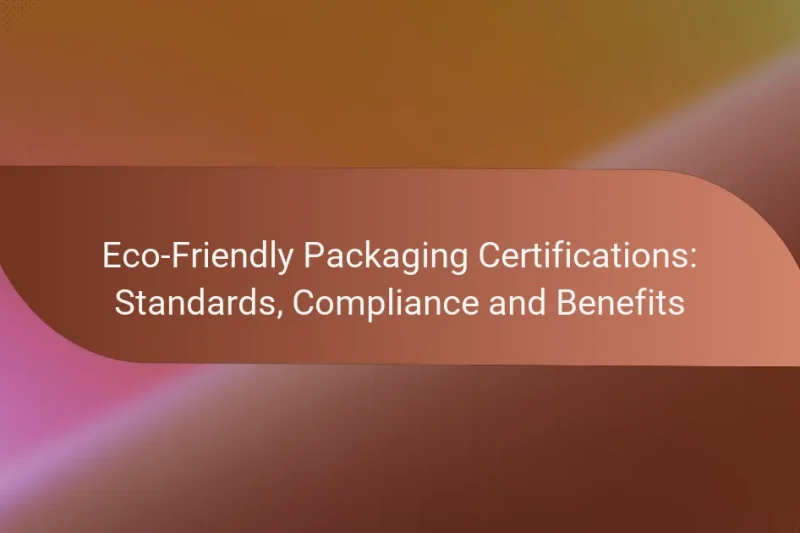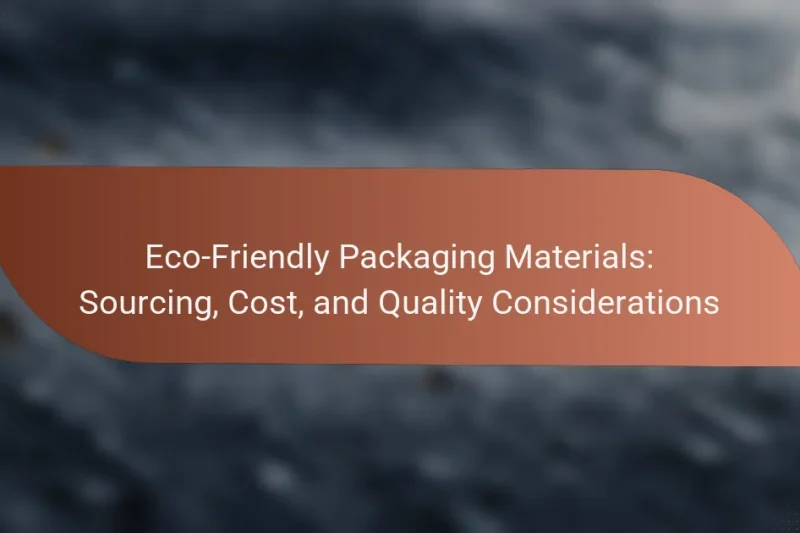In the ongoing quest for sustainable solutions, biodegradable and recyclable packaging emerge as two prominent options, … Biodegradable vs. Recyclable Packaging: Benefits, Use Cases and Environmental ImpactRead more
Eco-Conscious Gift Packaging Services: Sustainable Materials
Eco-conscious gift packaging services prioritize the use of sustainable materials and practices to create environmentally friendly packaging solutions. By utilizing options such as recycled paper and biodegradable plastics, these services help consumers and businesses reduce waste while promoting a greener gifting experience.
Eco-Friendly Packaging Certifications: Standards, Compliance and Benefits
Eco-friendly packaging certifications play a crucial role in promoting sustainability and environmental responsibility in the marketplace. … Eco-Friendly Packaging Certifications: Standards, Compliance and BenefitsRead more
Plant-Based Inks: Environmental Benefits, Durability and Color Quality
Plant-based inks are an eco-friendly alternative to traditional petroleum-based inks, significantly reducing pollution and conserving natural … Plant-Based Inks: Environmental Benefits, Durability and Color QualityRead more
Eco-Friendly Packaging Materials: Sourcing, Cost, and Quality Considerations
In today’s environmentally conscious market, selecting eco-friendly packaging materials is essential for e-commerce businesses. Options such … Eco-Friendly Packaging Materials: Sourcing, Cost, and Quality ConsiderationsRead more
Sourcing Sustainable Packaging: Local Suppliers, Cost and Quality Assurance
Sourcing sustainable packaging from local suppliers is essential for businesses aiming to reduce their environmental impact … Sourcing Sustainable Packaging: Local Suppliers, Cost and Quality AssuranceRead more
What are eco-conscious gift packaging services?
Eco-conscious gift packaging services focus on using sustainable materials and practices to create packaging solutions that minimize environmental impact. These services cater to consumers and businesses seeking to reduce waste and promote eco-friendly alternatives in their gifting processes.
Definition of eco-conscious packaging
Eco-conscious packaging refers to materials and methods that prioritize environmental sustainability. This can include biodegradable, recyclable, or reusable materials that reduce the carbon footprint associated with traditional packaging options.
Examples of eco-conscious packaging materials include recycled paper, plant-based plastics, and compostable wraps. Companies often use these materials to align their brand with sustainability goals and appeal to environmentally aware consumers.
Importance of sustainability in packaging
Sustainability in packaging is crucial for reducing waste and conserving natural resources. With increasing awareness of environmental issues, consumers are more likely to support brands that prioritize eco-friendly practices.
Implementing sustainable packaging can also enhance a company’s reputation and customer loyalty. Brands that adopt eco-conscious packaging often experience a positive response from consumers, which can lead to increased sales and market share.
To effectively incorporate sustainability, businesses should consider factors such as sourcing materials locally, minimizing packaging size, and ensuring that all components are recyclable or compostable. This approach not only benefits the environment but can also lead to cost savings in the long run.
What materials are used in sustainable gift packaging?
Sustainable gift packaging primarily utilizes eco-friendly materials that minimize environmental impact. Common options include recycled paper, biodegradable plastics, and plant-based materials, each offering unique benefits for reducing waste and promoting sustainability.
Recycled paper and cardboard
Recycled paper and cardboard are widely used in sustainable gift packaging due to their lower environmental footprint. These materials are made from post-consumer waste, which helps reduce landfill contributions and saves trees. When selecting recycled options, look for products with a high percentage of recycled content to maximize sustainability.
Consider using recycled kraft paper or cardboard boxes, which are not only eco-friendly but also provide a rustic aesthetic. Many suppliers offer a variety of colors and textures to enhance the visual appeal of your packaging while remaining environmentally conscious.
Biodegradable plastics
Biodegradable plastics are designed to break down more quickly than traditional plastics, making them a better choice for sustainable gift packaging. These materials can decompose in composting conditions, reducing long-term waste in landfills. However, it’s essential to check for certifications that confirm their biodegradability, such as ASTM D6400 or EN 13432.
When using biodegradable plastics, consider their applications, such as bags or wraps for gifts. Ensure that they are disposed of correctly to take advantage of their eco-friendly properties, as they require specific conditions to decompose effectively.
Plant-based materials
Plant-based materials, such as those derived from cornstarch or sugarcane, are increasingly popular in sustainable gift packaging. These materials are renewable and can often be composted, making them an excellent alternative to conventional plastics. Look for products labeled as compostable to ensure they meet environmental standards.
Examples of plant-based packaging include biodegradable packing peanuts and compostable mailers. When choosing plant-based options, consider their lifecycle and disposal methods to ensure they align with your sustainability goals.
How to choose eco-friendly packaging services?
Choosing eco-friendly packaging services involves evaluating providers based on their sustainability practices and material sources. Look for companies that prioritize biodegradable, recyclable, or reusable materials to minimize environmental impact.
Criteria for selecting sustainable providers
When selecting sustainable packaging providers, consider their certifications and adherence to environmental standards, such as FSC or Cradle to Cradle. Assess their sourcing practices to ensure they use renewable resources and avoid harmful chemicals.
Additionally, evaluate their production processes for energy efficiency and waste reduction. A transparent supply chain is crucial; providers should openly share information about their sustainability efforts and material origins.
Comparing service offerings
To effectively compare eco-friendly packaging services, create a checklist of key features such as material types, customization options, and pricing. Look for providers that offer a range of sustainable materials, including recycled paper, compostable plastics, and plant-based options.
Consider the scalability of their services. Some providers may cater to small businesses with low minimum order quantities, while others may focus on larger enterprises. Review customer feedback to gauge reliability and service quality, which can be just as important as sustainability.
What are the benefits of using sustainable packaging?
Using sustainable packaging offers numerous advantages, including reduced environmental impact and improved brand perception. By choosing eco-friendly materials, businesses can contribute to a healthier planet while appealing to environmentally conscious consumers.
Environmental impact reduction
Sustainable packaging significantly lowers the environmental footprint of products. Materials such as recycled paper, biodegradable plastics, and plant-based alternatives help minimize waste and decrease reliance on fossil fuels. This shift can lead to lower greenhouse gas emissions and reduced landfill contributions.
Businesses should consider the life cycle of packaging materials, from production to disposal. Opting for locally sourced materials can further reduce transportation emissions and support local economies. Regularly assessing packaging practices against sustainability standards can help identify areas for improvement.
Brand image enhancement
Adopting sustainable packaging can greatly enhance a brand’s image. Consumers are increasingly drawn to companies that prioritize environmental responsibility, and sustainable practices can differentiate a brand in a competitive market. This positive perception can lead to increased customer loyalty and higher sales.
To effectively communicate sustainability efforts, brands should transparently share their packaging choices and the benefits of those materials. Engaging in eco-friendly initiatives, such as partnerships with environmental organizations or participation in sustainability certifications, can further strengthen brand credibility and appeal to a broader audience.
What are the costs associated with eco-friendly packaging?
The costs of eco-friendly packaging can vary significantly based on materials, design, and production methods. Generally, businesses may find that while initial expenses can be higher than traditional options, the long-term benefits often justify the investment.
Price comparison with traditional packaging
Eco-friendly packaging typically costs more than conventional packaging due to the use of sustainable materials like recycled paper, biodegradable plastics, and organic fabrics. For instance, while traditional cardboard boxes may range from 50 cents to a few dollars each, eco-friendly alternatives can start at around 1 to 3 dollars, depending on the complexity and material.
However, as demand for sustainable options increases, prices are gradually becoming more competitive. Companies can often negotiate bulk discounts or find local suppliers that reduce shipping costs, further balancing the price difference.
Long-term savings from sustainable practices
Investing in eco-friendly packaging can lead to significant long-term savings. Businesses may experience reduced waste disposal costs, as many sustainable materials are designed to be compostable or recyclable, lowering landfill fees. Additionally, using sustainable packaging can enhance brand loyalty, attracting environmentally conscious consumers willing to pay a premium.
Moreover, companies that adopt sustainable practices often see operational efficiencies, such as reduced material usage and improved supply chain logistics. This can translate to savings of 10-20% over time, making eco-friendly packaging not just a responsible choice, but a financially sound one as well.
How do major brands implement sustainable packaging?
Major brands implement sustainable packaging by using eco-friendly materials, reducing waste, and optimizing their supply chains. This approach not only meets consumer demand for environmentally responsible products but also often leads to cost savings over time.
Case studies of successful brands
Brands like Unilever and Coca-Cola have made significant strides in sustainable packaging. Unilever has committed to making all of its plastic packaging recyclable, reusable, or compostable by 2025, while Coca-Cola aims to collect and recycle a bottle or can for every one sold by 2030.
Another example is Nestlé, which is transitioning to biodegradable packaging for its products. These initiatives demonstrate how large companies can lead the way in sustainability while maintaining brand loyalty and consumer trust.
Innovative packaging solutions
Innovative packaging solutions include the use of plant-based materials, such as bioplastics made from corn or sugarcane, which can significantly reduce carbon footprints. Additionally, companies are exploring water-soluble packaging for single-use items, which dissolves in water, leaving no waste behind.
Another trend is the implementation of minimalist packaging designs that use less material without compromising product protection. Brands can also consider reusable packaging systems, where consumers return containers for refills, fostering a circular economy.
What are the future trends in eco-conscious packaging?
Future trends in eco-conscious packaging focus on reducing environmental impact through innovative materials and processes. Brands are increasingly adopting sustainable practices to meet consumer demand for greener options, which includes using biodegradable, recyclable, and reusable materials.
Emerging materials and technologies
Emerging materials in eco-conscious packaging include bioplastics, mushroom-based packaging, and recycled paper products. These materials not only minimize waste but also reduce reliance on fossil fuels. For instance, bioplastics made from corn starch can decompose in industrial composting facilities, offering a viable alternative to traditional plastics.
Technological advancements are also playing a significant role in sustainable packaging. Innovations such as water-soluble films and edible packaging are gaining traction. These technologies can significantly reduce packaging waste and enhance the overall sustainability of products.
When selecting materials, consider factors such as lifecycle analysis and end-of-life disposal options. It’s crucial to evaluate how these materials can be integrated into existing supply chains and whether they align with local regulations regarding waste management and recycling.




